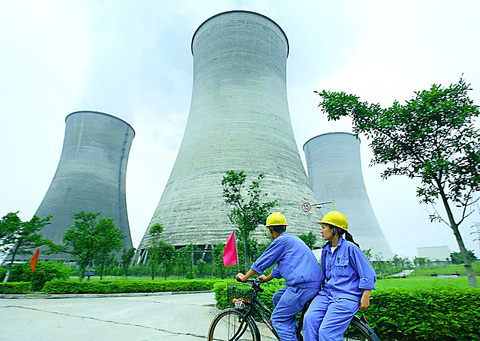In its anxiety to satisfy its seemingly bottomless demand for electricity, China plans to build nuclear reactors on a scale and pace comparable to the most ambitious nuclear energy programs the world has ever seen.
Current plans -- conservative ones, in the estimation of some people involved in China's nuclear energy program -- call for new reactors to be commissioned at a rate of nearly two a year between now and 2020, a pace that experts say is comparable to the peak of the US' nuclear energy push in the 1970s.

PHOTO: AFP
"We will certainly build more than one reactor per year," said Zhou Dadi, director of the central government's Energy Research Institute, which has strongly supported the country's nuclear program.
"The challenge is not the technology. The barriers for China are mostly institutional arrangements, because reactors are big projects. What we need most is better operation, financing and management," Zhou said.
By 2010, planners predict a quadrupling of nuclear output to 16 billion kilowatt-hours and a doubling of that figure by 2015. And with commercial nuclear energy programs dead or stagnant in the US and most of Europe, Western and other developers of nuclear plant technology are lining up to sell reactors and other equipment to China, whose purchasing decisions alone will determine in many instances who survives in the business.
The problem with nuclear power, some experts say, is that China's energy needs are so immense that even the enormous expansion program will do little to offset the skyrocketing power demand.
China's eight nuclear reactors in operation today supply less than 2 percent of current demand. By 2020, assuming the national plan is fulfilled, nuclear energy would still constitute under 4 percent of demand.
There has been almost no public discussion of the merits and risks of nuclear energy here, as the government strictly censors news coverage of such issues. But critics of the program question whether such a small payoff warrants exposure to the risks.
"We don't have a very good plan for dealing with spent fuel, and we don't have very good emergency plans for dealing with catastrophe," said Wang Yi, a nuclear energy expert at the Chinese Academy of Sciences in Beijing.
Chinese nuclear operators, like the people who run the plans at Daya Bay, scoff at such concerns.
"In China we have state-owned power companies, whereas abroad they have private companies," said Yu Jiechun, a senior engineer at the China Guangdong Nuclear Power Holding Co.
"It's not a matter of someone's profit here, whether we do something one way or another. The government decides, and they have spent huge amounts of money on safety," Yu said.

Taiwan’s long-term economic competitiveness will hinge not only on national champions like Taiwan Semiconductor Manufacturing Co. (TSMC, 台積電) but also on the widespread adoption of artificial intelligence (AI) and other emerging technologies, a US-based scholar has said. At a lecture in Taipei on Tuesday, Jeffrey Ding, assistant professor of political science at the George Washington University and author of "Technology and the Rise of Great Powers," argued that historical experience shows that general-purpose technologies (GPTs) — such as electricity, computers and now AI — shape long-term economic advantages through their diffusion across the broader economy. "What really matters is not who pioneers

In a high-security Shenzhen laboratory, Chinese scientists have built what Washington has spent years trying to prevent: a prototype of a machine capable of producing the cutting-edge semiconductor chips that power artificial intelligence (AI), smartphones and weapons central to Western military dominance, Reuters has learned. Completed early this year and undergoing testing, the prototype fills nearly an entire factory floor. It was built by a team of former engineers from Dutch semiconductor giant ASML who reverse-engineered the company’s extreme ultraviolet lithography (EUV) machines, according to two people with knowledge of the project. EUV machines sit at the heart of a technological Cold

Taiwan Semiconductor Manufacturing Co (TSMC, 台積電) last week recorded an increase in the number of shareholders to the highest in almost eight months, despite its share price falling 3.38 percent from the previous week, Taiwan Stock Exchange data released on Saturday showed. As of Friday, TSMC had 1.88 million shareholders, the most since the week of April 25 and an increase of 31,870 from the previous week, the data showed. The number of shareholders jumped despite a drop of NT$50 (US$1.59), or 3.38 percent, in TSMC’s share price from a week earlier to NT$1,430, as investors took profits from their earlier gains

TAIWAN VALUE CHAIN: Foxtron is to fully own Luxgen following the transaction and it plans to launch a new electric model, the Foxtron Bria, in Taiwan next year Yulon Motor Co (裕隆汽車) yesterday said that its board of directors approved the disposal of its electric vehicle (EV) unit, Luxgen Motor Co (納智捷汽車), to Foxtron Vehicle Technologies Co (鴻華先進) for NT$787.6 million (US$24.98 million). Foxtron, a half-half joint venture between Yulon affiliate Hua-Chuang Automobile Information Technical Center Co (華創車電) and Hon Hai Precision Industry Co (鴻海精密), expects to wrap up the deal in the first quarter of next year. Foxtron would fully own Luxgen following the transaction, including five car distributing companies, outlets and all employees. The deal is subject to the approval of the Fair Trade Commission, Foxtron said. “Foxtron will be